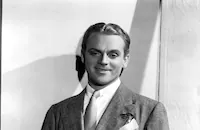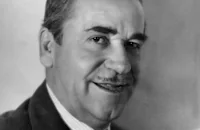The Millionaire

Brief Synopsis
Cast & Crew
John G. Adolfi
George Arliss
Florence Arliss
David Manners
Evalyn Knapp
James Cagney
Film Details
Technical Specs

Synopsis
James Alden, millionaire owner of an automobile factory, is ill from overwork and his doctor advises him to retire out West. He resists, but out of consideration for his wife Laura and daughter Barbara, nicknamed Babs, he finally agrees. At the California resort, Jim is bored. After learning from insurance salesman Schofield that retired men are bad risks, Jim follows his suggestion to buy and run a little business on the sly for his own amusement. Jim buys a half-interest in a gas station unaware that a new state highway will eventually bypass the busy location. He convinces his partner, Bill Merrick, a personable young man whose family has lost its money, to invest additional capital in the venture. With this money and Bill's talents as an architect, they open a new station across the road from the station's dishonest former owner, Peterson. Soon, most of Peterson's customers are patronizing the elegant new station. Even Babs stops there. She and Bill recognize each other from college and start to date. Jim, who is using the alias Charles Miller, has kept his business a secret, but is discovered first by Babs and then by Laura. They realize that the work has given Jim new life. When Peterson offers to buy the station, Jim manages to get enough money out of him for Bill to go into business as an architect and marry Babs. Now that he is well again, Jim returns to Alden Engineering.

Director

John G. Adolfi
Cast

George Arliss

Florence Arliss

David Manners

Evalyn Knapp

James Cagney

Bramwell Fletcher

Noah Beery

Ivan Simpson
J. C. Nugent

Sam Hardy

J. Farrell Macdonald
Charles E. Evans

Tully Marshall
Ethel Griffies
Ben Hall
Crew

Film Details
Technical Specs

Articles
The Millionaire
That was actually what Arliss had in mind from the start. The elderly actor held a unique position on the Warner Bros. lot. While other contract stars were very much under the thumb of studio head Jack Warner and his production team (then headed by Darryl F. Zanuck), Arliss pretty much called his own shots. After a surprise hit in Disraeli (1929) -- which Warner had made for prestige, not expecting much in the way of profits -- he seemingly could do no wrong. He not only decided to star in this remake of his silent success The Ruling Passion (1922) but also chose the cast and much of the crew. Major roles went to his wife, Florence Arliss, and friend David Manners, cast as the gas station owner dreaming of a career as an architect. Realizing that the one-scene role of an insurance salesman who unwittingly inspires the businessman to come out of retirement was very important to the film's success, Arliss personally interviewed the young players Warner proposed for the role. When he met Cagney, he was impressed that of all the actors, he was the only one who didn't seem to be acting. His natural behavior and innate cockiness were just what he wanted, and he instructed the casting department to have Cagney report for shooting just as he had dressed for his audition. When they rehearsed the scene on the set, Cagney asked if it would be all right if he adjusted Arliss' shawl should it fall from his shoulders during filming. The elder actor replied, "Young man, you do anything you like. I trust your judgment implicitly." The result was a charming scene in which Cagney's youthful enthusiasm provided the spur to Arliss' decision to go back to work.
Acting wasn't the only area of his career that Arliss controlled. For most of his later films, he assembled a company of technicians who worked with him consistently. For The Millionaire that included writers Maude T. Howell (uncredited) and Julien Josephson, who had worked on several of his earlier hits. Howell would even follow him to 20th Century Pictures when he left Warner's and provided screenplays for such later films as The House of Rothschild (1934) and Cardinal Richelieu (1935). Cinematographer James Van Trees and editor Owen Marks were also Arliss regulars, though they would remain to enjoy lengthy careers at Warner Bros. The film also marked the beginning of an association with director John Adolfi, who would helm all of Arliss's remaining pictures at Warner Bros. while also serving as a producing partner. He also had directed Cagney's debut film, Sinners' Holiday (1930).
Arliss' control extended to his working hours as well. Because of his age, he only worked from 9 a.m. to 4 p.m. Just to keep him from overtaxing himself, his valet, Jenner, would show up promptly at quitting time. If Arliss were still involved in a scene, even if the cameras were rolling, Jenner would walk right up to the star, remove his hat or coat, and take it to Arliss' dressing room, with the star following.
The Millionaire's writing credits boast two other names of note. The film was adapted from a 1921 Saturday Evening Post story by Earl Derr Biggers, best known as the creator of Charlie Chan. Under the dialogue credit, Warner Bros. listed Booth Tarkington, already a legend by 1931 for such popular novels about American life as Alice Adams , Seventeen and The Magnificent Ambersons.
The Millionaire opened to solid reviews and continued Arliss' winning streak at the box office. If it helped Cagney's career, though, it was mostly beneficial off-screen. By the time it opened in May, The Public Enemy (1931), although made afterwards, had already bowed, shooting Cagney to stardom with one of the screen's first modern portrayals of gang violence.
For his own part, Arliss would continue to demonstrate his keen eye for talent and generosity in sharing the screen with younger players. A year later he would bring Bette Davis to Warner Bros. to co-star as his youthful fiancée in The Man Who Played God (1932).
Producer-Director: John G. Adolfi
Screenplay: Julien Josephson, Booth Tarkington, Maude T. Howell
Based on the short story "Idle Hands" by Earl Der Biggers
Cinematography: James Van Trees
Art Direction: Esdras Hartley
Music: Alois Reiser
Cast: George Arliss (James Alden), Florence Arliss (Mrs. Laura Alden), David Manners (William "Bill" Merrick), Evalyn Knapp (Barbara "Babs" Alden), James Cagney (Schofield, Insurance Salesman), Bramwell Fletcher (Carter Andrews), Noah Beery (L. Peterson), Charley Grapewin (Edward "Ed" Powers), Tully Marshall (Mr. Briggs).
by Frank Miller

The Millionaire
Quotes
Trivia
Notes
The film's working title was The Ruling Passion. Earl Derr Biggers' story was first filmed in 1922 by United Artists as The Ruling Passion. The silent version also starred George Arliss and was directed by Harmon Weight (see AFI Catalog of Feature Films, 1921-30; F2.4731.) In 1947, Warner Bros. drew on the same material for That Way with Women which starred Sydney Greenstreet and was directed by Frederick de Cordova. Although not based on the Biggers' story, Warner Bros. 1936 film The Big Noise has a very similar plot.















